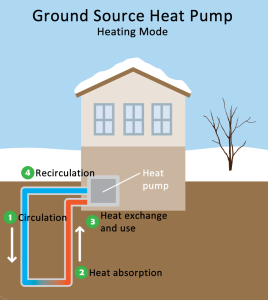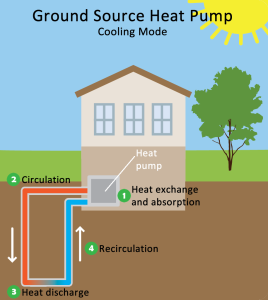What is Geothermal heating/Cooling? Geo is for geological and thermal means heat. Geothermal is an eco-friendly way to heat and cool spaces that uses the latent temperature difference that exist between above ground air and below ground soil temperatures. So geothermal heating is the process of using the environment to heat and cool our homes. There are different types of geothermal techniques but here we are going to focus on a ground source heat pump.
Let us start with describing what a heat pump is: a heat pump is in its basic form is an Air conditioning compressor that works in 2 directions. Many of us are familiar with central air conditioning systems. An air conditioning system does not magically add cold to the home. It actually removes heat from the home. What these systems do in a simple form is move heat from one location to another. For an air conditioning system, the heat it moved from the inside air to the outside air. A heat pump has a directional valve that can reverse the direction of the process to either move heat from inside the home to the outside air or from the outside air to the inside of the home.
Geothermal heat pumps use the ground instead of the air. In most sections of the world the ground temperature does not change much once below the frost line. The frost line is the depth at which the ambient air temperature no longer effects the ground temperature. This line will vary depending on where the home is located and if there are any other geological forms of ground heat. (i.e. volcanic) Geothermal systems can also use bodies of water such as lakes and ponds.
Depending on the season, the below ground temperatures will be higher or lower than the ambient air temperature. Understanding this we can use the temperature difference to work for our homes. For this example, let us think of a geothermal system being used for heat. In the winter the outside air temperature may be 32 degrees. Once we get to about 20-30 feet down the ground temperature is between 50-60 degrees. We can use a deep trench or drilled wells to embed a series of pipe loops or coils to circulate a heat-conveying fluid into the ground. Depending on how the system is operating the fluid can capture heat or disperse heat from the home.

Heating mode:
- The heat pump which is locate above ground usually in the home, will circulate water or another acceptable heat-conveying fluid through the buried pipe loops or coils.
- The fluid ground loops absorb heat as it moves through the ground soil, rock or ground water.
- The fluid is returned to the home where it can be used to heat the air or water. These systems will use a heat exchanger to transfer the heat to a coil in an air handler, distribution, or ventilation system.
- Once the heat is released the coolers fluid circulates back into the ground to be reheated. The process repeats until the system is satisfied.
 Cooling mode:
Cooling mode:
- The fluid circulates through the heat exchanger/air handler in the home where it absorbs heat from the air in the home. (Very much like a typical air conditioning system)
- The heated fluid is then circulated into the ground through a series of ground loops or coils.
- As the fluid moves through the ground source material, it gives off heat to the coolers solid, rock or ground water that surrounds the pipes.
- The fluid is then recirculated to the home at a lower temperature where it can absorb more heat to be moved out of the home.
Why is geothermal considered a green ecofriendly alternative?
The heat pumps are relatively inexpensive, and the electrical cost is low to move the fluid through the system. There is no cost to generate the heat from the ground. The most expensive part of a geothermal system is the installation of the ground loops or coils. To install a geothermal to an existing home typically requires drilling wells in several areas to get enough surface to have efficient heat exchange. In a new home construction, the coils can be buried in trenches that can allow for more heat exchange in smaller area. If the geothermal system is paired with solar supplied electricity, it could be operated at an almost zero carbon footprint.
For more information please feel from to contact us at Pondview Inspections, LLC or go the EPA website. https://www.epa.gov/rhc/geothermal-heating-and-cooling-

